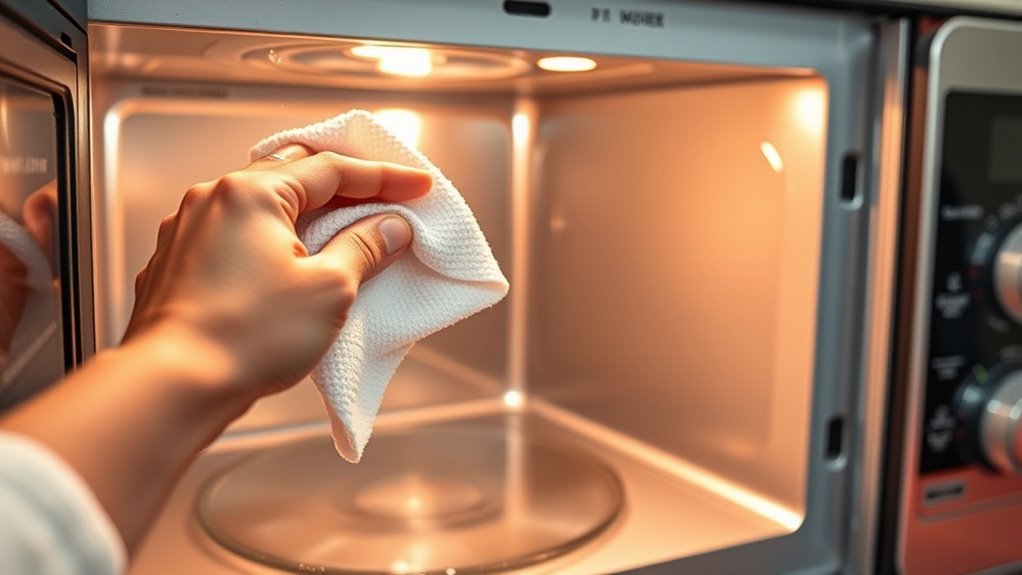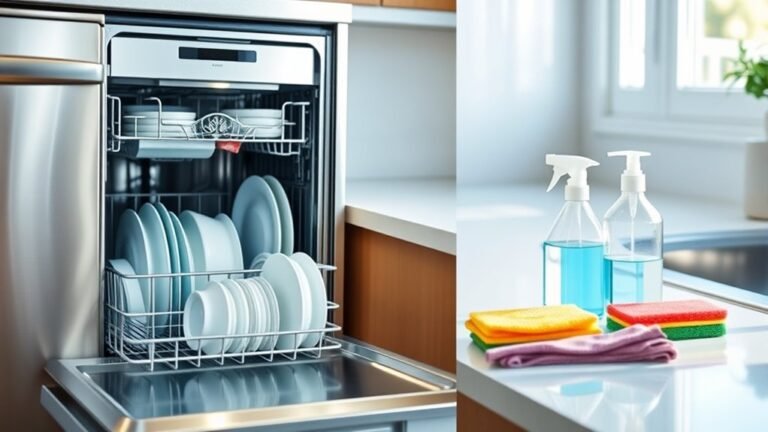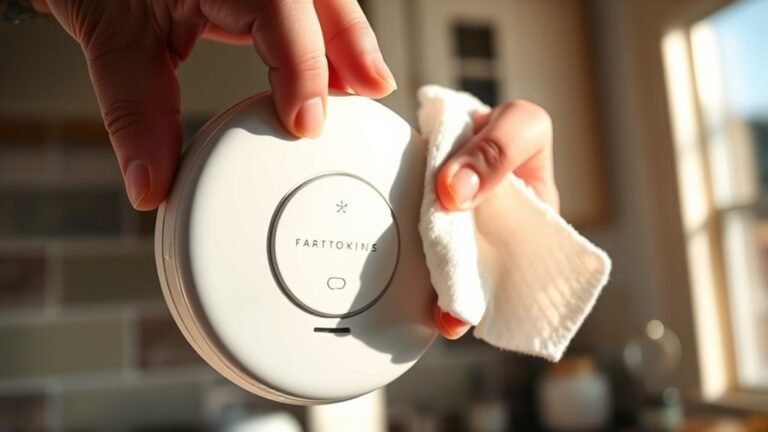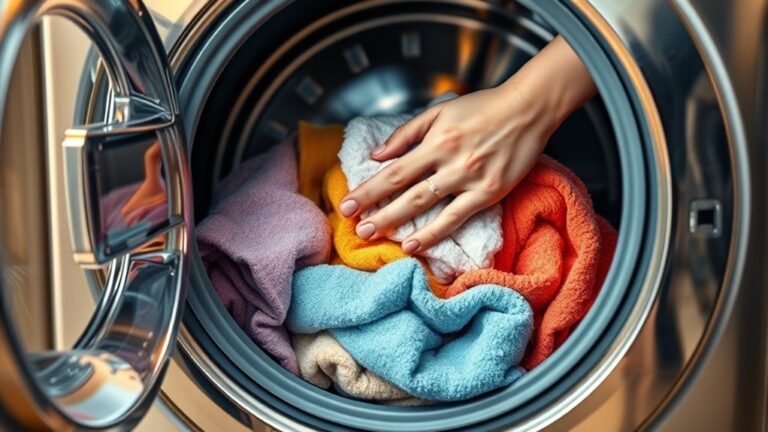Washing Microwave Without Damage
To wash your microwave without causing damage, use gentle, non-abrasive materials like microfiber cloths and natural cleaners such as vinegar or lemon juice. Always unplug and cool the microwave before cleaning, and remove any parts like the turntable. Steam cleaning with a water-vinegar mix loosens grime safely, while wiping frequently prevents buildup and odors. Avoid harsh chemicals or scrubbing tools that scratch surfaces. Keep these tips in mind as you explore ways to keep your microwave spotless and long-lasting.
Choosing the Right Cleaning Materials

When it comes to choosing the right cleaning materials for your microwave, you’ll want to pick products that are effective yet gentle enough to avoid damage. Avoid abrasive materials that can scratch the interior surfaces and reduce the appliance’s lifespan. Instead, opt for eco friendly options like microfiber cloths and natural cleaning solutions that protect both your microwave and the environment. These alternatives not only keep your microwave spotless but also give you the freedom to clean without harsh chemicals or wasted resources. By selecting the right tools, you maintain your microwave’s performance while aligning with a lifestyle that values sustainability and care. Choosing wisely means you can enjoy a clean microwave without compromising on quality or your principles.
Preparing Your Microwave for Cleaning
Before you start cleaning, make certain your microwave is unplugged and completely cooled down to prevent any accidents or burns. Prioritizing microwave safety helps you avoid electrical hazards and guarantees a stress-free cleaning session. Next, remove the turntable and any removable parts, giving you clear access to all surfaces. Wipe away loose crumbs or spills with a dry cloth to prevent smearing during cleaning. Keeping a consistent cleaning frequency—ideally once a week or after spills—makes maintenance easier and prevents buildup. Taking these simple preparation steps lets you clean effectively without risking damage or injury. Remember, a little care upfront sets you free from tough grime and extends your microwave’s life, letting you enjoy hassle-free use every day.
Using Natural Cleaning Solutions

You can easily clean your microwave using natural solutions like a vinegar and water mix, which helps loosen grime without harsh chemicals. Lemon juice is another great option, offering a fresh scent while cutting through stains. These methods keep your microwave safe and smelling fresh.
Vinegar and Water Mix
Although it might seem simple, using a vinegar and water mix is one of the most effective natural ways to clean your microwave without causing damage. This combo taps into vinegar benefits like cutting grease and neutralizing odors, all while respecting water safety by avoiding harsh chemicals. You get a powerful clean that’s gentle on your appliance and the environment.
Here’s how this mix frees you from tough microwave grime:
- Mix equal parts white vinegar and water in a microwave-safe bowl.
- Heat the mixture until it steams to loosen stuck-on food.
- Carefully wipe down the interior with a soft cloth or sponge.
- Enjoy a fresh, chemical-free microwave ready for your next meal.
This simple method gives you freedom from harsh cleaners and keeps your microwave safe.
Lemon Juice Benefits
Lemon juice offers a natural, effective way to clean your microwave while leaving a clean scent behind. When you use lemon juice, you’re not only cutting through grime but also harnessing its power as a natural disinfectant. This means you can skip harsh chemicals and still keep your microwave spotless and safe. Just squeeze fresh lemon juice into a microwave-safe bowl with water, heat it until it steams, then wipe down surfaces easily. The natural acids in lemon juice break down food residues and kill bacteria, giving you a clean space without the worry of toxic residues. Plus, its invigorating aroma makes the chore feel less like a task and more like reclaiming your freedom to enjoy a clean kitchen naturally.
Step-by-Step Microwave Cleaning Process
Before you start, gather all your cleaning materials to make the process smooth. You’ll first focus on cleaning the microwave’s interior to remove food splatters and odors. Then, you’ll maintain the exterior surfaces to keep your appliance looking fresh and spotless.
Preparing Cleaning Materials
Gathering three essential cleaning materials will make washing your microwave quick and safe. Before diving in, focus on having the right cleaning supplies and observing safety precautions to protect yourself and your appliance. Here’s what you’ll need:
- A mild dish soap or microwave-safe cleaner
- A soft sponge or microfiber cloth
- A spray bottle filled with water and white vinegar
- Disposable gloves to keep your hands safe
With these items ready, you’re set to clean without damaging your microwave. Using gentle supplies and taking safety precautions guarantees you maintain freedom from harsh chemicals and avoid scratches or electrical hazards. This preparation step is key to a smooth, effective cleaning experience.
Microwave Interior Cleaning
A few simple steps can make cleaning your microwave’s interior quick and effective. Start by placing a microwave-safe bowl filled with water and a splash of vinegar or lemon juice inside. Run the microwave on high for about 5 minutes to create steam cleaning that loosens stubborn food splatters. When the timer’s up, keep the door closed for a couple of minutes to let the steam work its magic. Carefully remove the bowl, then wipe down the interior walls, ceiling, and turntable with a soft cloth or sponge. This method frees you from scrubbing hard-to-reach spots and prevents damage. Repeat as needed to keep your microwave fresh and spotless, giving you the freedom to enjoy cooking without the hassle of tough messes.
Exterior Surface Maintenance
Once you’ve tackled the microwave’s interior, it’s just as important to give the exterior some attention to keep it looking clean and functioning well. Different surface types—like stainless steel, plastic, or painted finishes—need specific care to avoid damage. Adjust your cleaning frequency based on use; a weekly wipe-down usually works for most homes.
Here’s how to maintain your microwave’s exterior:
- Use a soft cloth dampened with mild soap and water.
- Avoid abrasive sponges that can scratch delicate surfaces.
- Wipe control panels gently to prevent moisture damage.
- Dry thoroughly to prevent streaks or water spots.
Tips for Removing Tough Stains and Odors
Removing tough stains and odors from your microwave doesn’t have to be a hassle. You can achieve effective stain removal and odor neutralization with simple, natural ingredients that protect your microwave’s interior. Here’s a quick guide to help you regain a fresh, clean microwave without damage:
| Method | Ingredients | Zweck |
|---|---|---|
| Steam Cleaning | Water + Lemon Slices | Loosens stains |
| Baking Soda Paste | Baking Soda + Water | Scrubs stubborn stains |
| Vinegar Steam | Water + White Vinegar | Neutralizes odors |
| Charcoal | Activated Charcoal | Absorbs lingering smells |
Follow these tips to maintain a spotless microwave, ensuring your freedom to cook and clean with ease and confidence.
Avoiding Common Microwave Cleaning Mistakes

Though it might seem straightforward, cleaning your microwave the wrong way can cause damage or reduce its efficiency. To keep your microwave safe and working well, you need to avoid some common cleaning mistakes. Here are some microwave safety tips to help you out:
Cleaning your microwave incorrectly can damage it; follow safety tips to keep it efficient and safe.
- Don’t use abrasive cleaners or scrubbers that can scratch the interior.
- Avoid spraying water directly inside to prevent electrical damage.
- Never put metal objects or foil inside during cleaning.
- Don’t forget to unplug your microwave before you start cleaning.
Maintaining Your Microwave’s Cleanliness Regularly
If you want your microwave to stay efficient and odor-free, cleaning it regularly is crucial. Setting a clear maintenance schedule helps you avoid buildup and prolongs your appliance’s life. Your cleaning frequency depends on usage—daily for heavy use, weekly for moderate, and biweekly for light use.
| Cleaning Task | Recommended Frequency | Benefits |
|---|---|---|
| Wiping interior | After every use | Prevents stains, odors |
| Deep cleaning | Weekly or biweekly | Removes tough grime |
| Checking vents | Monthly | Guarantees proper airflow |
Stick to this routine, and you’ll enjoy a hassle-free, fresh microwave that’s always ready for your next meal. Freedom means less worry about your appliances!
Häufig gestellte Fragen
Can I Use a Dishwasher to Clean Microwave Parts?
You might wonder if you can toss microwave parts in the dishwasher. While some microwave parts are dishwasher safe, it’s essential to check the manufacturer’s guidelines first. Not all parts can handle the heat and water pressure without damage. To keep your freedom from worrying about broken pieces, consider hand washing delicate components. This way, you maintain your microwave’s lifespan without sacrificing convenience or safety.
Is It Safe to Clean the Microwave’s Electronic Components?
You shouldn’t clean your microwave’s electronic components directly because it risks damage and voids warranties. For microwave safety tips, avoid moisture near circuits and never immerse parts with electronics in water. Instead, focus on surface cleaning and use damp cloths on non-electrical areas. Taking care of electronic components means keeping them dry and free from debris, so you can enjoy your microwave freely without risking costly repairs or safety issues.
How Often Should the Microwave Filter Be Replaced?
Did you know that a clogged microwave filter can reduce efficiency by up to 30%? For your freedom to cook without hassle, stick to microwave maintenance tips like replacing the filter every 3 to 6 months, depending on usage. Following these filter replacement guidelines keeps odors and grease at bay, ensuring your microwave works smoothly. Keeping up with this simple step lets you enjoy your kitchen time without unnecessary interruptions.
Can Microwave-Safe Ceramic Be Washed Inside the Microwave?
Yes, you can use microwave-safe ceramics inside the microwave without worry. These ceramics are designed to handle the heat and won’t crack or release harmful chemicals. However, when it comes to cleaning microwave interiors, it’s best to avoid harsh scrubbing on ceramic surfaces to keep them looking great. So go ahead, enjoy the freedom of using your microwave-safe ceramics for heating and even simple cleaning hacks!
Does Cleaning the Microwave Affect Its Warranty?
Ever wonder if scrubbing your microwave could void its warranty coverage? Good news—it usually won’t, as long as you stick to the recommended cleaning methods in your manual. Using harsh chemicals or abrasive tools might cause damage that’s not covered, but gentle wipes with mild detergents keep you safe. So, why limit yourself? Clean your microwave confidently, knowing you’re protecting both your appliance and your freedom to maintain it.






